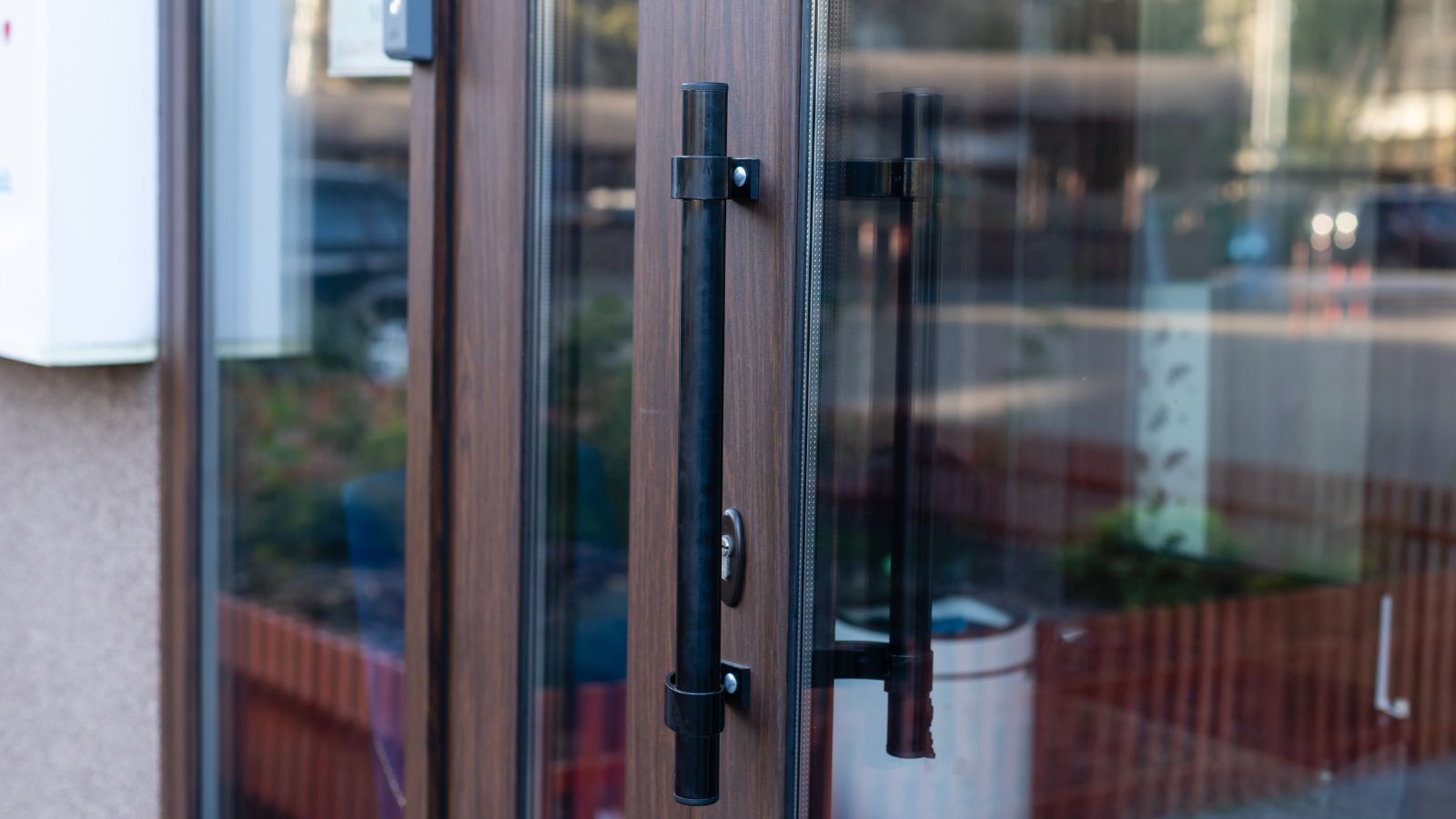What does a business’s front door say to you before you even step inside? Does a heavy, ornate wooden door make you feel like the business is traditional and trustworthy? Does an all-glass automatic door feel modern and welcoming?
These aren’t just idle observations—they’re the foundation of a customer’s entire experience with your brand. As an interior designer who’s spent over two decades helping businesses create memorable spaces, I can tell you that the commercial door is far more than just a point of entry. It’s the first piece of brand communication a potential customer interacts with, a silent handshake that can either draw people in or subtly turn them away.
This single design choice influences customer perception, sets expectations for the experience inside, and ultimately impacts a business’s bottom line. Let’s explore how this often-overlooked element can transform your business’s first impression.
More Than an Entrance: The Door as a Brand’s First Statement
The moment someone approaches your business, their brain starts making split-second judgments. Psychologists call this “thin-slice judgments”—the human ability to form impressions in milliseconds based on minimal information. Your commercial door is often the primary data point in this lightning-fast assessment.
Think about it: before customers see your products, meet your staff, or experience your service, they encounter your entrance. This interaction shapes their expectations and primes them for everything that follows.
Setting the Tone: From Welcoming to Exclusive
Different door designs immediately establish the character of your business, sending distinct psychological signals:
Wide Glass Doors suggest transparency, confidence, and a welcoming atmosphere. When customers can see inside before entering, it reduces anxiety and creates a sense of openness. This design choice is particularly effective for modern tech companies, cafes, and retail spaces where you want to showcase your interior environment.
Heavy, Solid Doors (whether wood or metal) imply security, tradition, and exclusivity. These entrances suggest that what lies beyond is valuable and worth protecting. Law firms, high-end jewelers, and private clubs often choose this approach to convey gravitas and discretion.
Brightly Colored Doors signal creativity, fun, and a friendly brand personality. A vibrant entrance suggests a business that isn’t afraid to stand out and values personal expression. This approach works beautifully for boutiques, toy stores, and creative agencies.
Minimalist or Hidden Doors create a sense of intrigue and high-end mystique. When the entrance is understated or seamlessly integrated into the facade, it suggests exclusivity and sophistication—a strategy often employed by exclusive restaurants and art galleries.
The Subconscious Promise of an Experience
The condition and design of your entrance set expectations about attention to detail. A grand, well-maintained door suggests a business that values quality and pays attention to the small things. Conversely, a neglected entrance can signal indifference or decline, regardless of how exceptional the actual products or services might be.
I once worked with a high-end restaurant whose business was struggling despite excellent food and service. The issue? Their entrance featured a beautiful but constantly malfunctioning automatic door. Customers unconsciously associated this frustration with the dining experience before they even sat down. After replacing it with elegant manual doors featuring premium commercial door hardware, customer satisfaction scores improved measurably.

Designing the Perfect Welcome: Material, Function, and Flow
Creating an impactful commercial entrance requires careful consideration of both aesthetic and functional elements. This is where the collaboration between business owners and design professionals becomes crucial.
Materiality and Lasting Impressions
The materials you choose for your entrance speak volumes about your brand values and target audience.
Wood offers timeless appeal and natural warmth. From rustic reclaimed planks that suggest authenticity and environmental consciousness to polished mahogany that conveys luxury and tradition, wood provides incredible versatility. However, it requires ongoing maintenance and may not suit all climates or security requirements.
Glass creates an open, connected feel between interior and exterior spaces. It’s perfect for businesses that want to showcase their environment—think retail stores displaying merchandise or restaurants highlighting their ambiance. Modern glass technologies also offer security and energy efficiency that rival traditional materials.
Steel and Aluminum provide durability and a sleek, contemporary aesthetic. These materials convey strength and modernity, making them ideal for tech companies, medical facilities, or any business wanting to project innovation and reliability. The key is in the details—the quality of commercial door hardware can make the difference between industrial-chic and simply industrial.
Functionality: The Ultimate Welcome Mat
Beautiful design means nothing if your door doesn’t function flawlessly. Several functional considerations can make or break the customer experience:
Accessibility isn’t just a legal requirement—it’s a powerful message of inclusivity. ADA-compliant doors with proper clearances, opening forces, and hardware heights demonstrate that your business values all customers. This consideration extends beyond compliance to create a genuinely welcoming environment.
Automatic versus Manual doors each offer distinct advantages. Automatic doors provide modern convenience and are excellent for businesses with high traffic or customers carrying items. However, manual doors with well-chosen hardware offer a tactile experience that can reinforce brand character. The decision often comes down to your specific customer needs and brand personality.
Hardware Selection deserves special attention because it’s the one part of the entrance that customers physically touch. Is the handle heavy and substantial, suggesting quality and permanence? Or is it sleek and minimal, conveying modern efficiency? This tangible interaction creates a lasting sensory memory that influences overall perception.
The Door as a Chapter in Your Brand’s Narrative
The most effective commercial entrances don’t exist in isolation—they’re integral parts of a cohesive brand story that continues throughout the customer experience.
Creating Seamless Transitions
The design of your exterior doors should flow naturally into your interior design scheme. Materials, colors, and style elements should either echo or complement what customers find inside. This continuity reinforces brand consistency and creates a sense of intentional, professional design.
For example, if your interior features warm wood tones and brass accents, incorporating these elements into your entrance design creates immediate brand recognition. Conversely, an ultra-modern interior preceded by a traditional entrance can create cognitive dissonance that undermines brand trust.
Branding Through Customization and Strategic Details
Smart businesses leverage their entrances for subtle but effective branding:
Custom Elements like etched logos on glass or unique hardware designs create memorable touchpoints that reinforce brand identity without being heavy-handed.
Strategic Lighting transforms your entrance after dark, extending your business hours for brand impression. Well-designed lighting enhances security while creating an inviting beacon that draws customers in.
Thoughtful Framing treats the entire entrance as a picture frame for your business. The color and material of the door frame literally frames your brand, drawing the eye inward and creating visual interest from the street.
Quality Commercial Door Hardware serves both functional and aesthetic purposes. Premium hardware not only ensures smooth operation and longevity but also communicates attention to detail and quality standards that customers unconsciously apply to your entire business.
Working with experienced designers can help you navigate these choices effectively, ensuring every element contributes to your overall brand strategy rather than working against it.
Key Takeaways for Your Business
Your commercial door represents a fundamental marketing and design tool that’s working 24/7 to shape customer perceptions. Its design—from material selection and color choices to accessibility features and branding elements—critically influences first impressions and sets expectations for the entire customer experience.
The investment in thoughtful entrance design pays dividends through improved customer perception, increased foot traffic, and enhanced brand recognition. Whether you’re opening a new location or refreshing an existing space, your entrance deserves the same strategic consideration you’d give to any other major marketing initiative.
The next time you approach any business, take a moment to consider its entrance. Notice how the door makes you feel before you even interact with the brand inside. The door truly is more than just a passage—it’s the cover of your business’s book. For any business owner, ensuring it tells the right story is the first step toward creating happy, loyal customers who understand your value before they even walk through the door.

